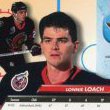-
Posts
88 -
Joined
-
Last visited
-
Days Won
5
Content Type
Profiles
Forums
Events
Everything posted by Loach
-
Wow, that's quite the upset.
-
Actually for adult hockey (including NHL), you don't have to put someone in the box immediately to serve the major for someone who got a major and a game misconduct. You can put someone in there at a whistle later on in the major so the player can come out of the penalty box before time expires. The risk you take is that if there are no whistles, the powerplay could be longer than 5 minutes until there is a stoppage. Coaches almost always put a player in the box to serve anyways, but I remember Babcock didn't and got burned a couple of years ago: https://nhl.nbcsports.com/2017/03/23/its-all-my-fault-mike-babcock-takes-responsibility-for-penalty-box-blunder/ But, the point is that in adult hockey you wouldn't have to put someone in the box if the major happened at the end of the game. So, I was going to write that the coach didn't have to put a kid in the box, but I just looked it up and it turns out they have a different rule for youth than adult hockey, saying that a substitute player must serve immediately for youth. If you are interested, the different rules for youth and adult is spelled out in section d) of Rule 403: https://www.usahockeyrulebook.com/page/show/1084479-rule-403-major-penalties Not sure why they bother to have separate rules for something like this. So, the rule is already basically already there, it just doesn't apply to youth hockey for some reason.
-
SCIR looks strong. Anyone see NP Wildcats play yet this year?
-

Maybe one of pgh’s biggest money grabs
Loach replied to whome87's topic in Western Pennsylvania Youth Hockey
Well, kudos for putting it all out there. I agree that the AAA label thing has gotten out of hand, but if you and your kid are going in with eyes wide open looking for a challenge, then best of luck to you both. -
Thanks. Icemen should probably be on there somewhere, maybe top 5.
-

Middle School hockey
Loach replied to AAAAleaguestarter's topic in Western Pennsylvania Youth Hockey
I get what you are saying LLB, and I would not go back in time and take body checking out of my youth hockey playing days so I've struggled with this. Even though I got diagnosed with two official concussions and probably had a few more undiagnosed, I still miss the thrill of laying a good hit when I'm playing in the beer league that I'm currently in. I'm not advocating removing body checking from NHL, AHL/ECHL, College or AAA programs. But, I was at a house game in the spring and watched a couple of bigger kids taking runs at a couple of smaller kids that were clearly relative beginners to the game. And it really hit me as what is really the point in having body checking at this level? Seemed pointless and there was the rare hit that actually served the purpose of causing a turn-over with the puck. It was pretty ridiculous to watch to be honest and I couldn't really come up with a good reason for why body checking should be allowed in a league like this beyond this is just the way it is. I think if you kept body-checking at AAA and the top AA divisions in a league like PAHL, it would work. We played a Toronto 2005 team (AA division) last year that played in a non-body-checking league there but played body checking in a tourney with us in Detroit. They seemed to adapt fine and I was actually pretty impressed with their team. I think kids who are bubble kids cut from AA teams would adapt fine after a couple of weeks if they make it the following year. Bubble cuts for AAA could play in the body checking AA league. -

Middle School hockey
Loach replied to AAAAleaguestarter's topic in Western Pennsylvania Youth Hockey
Yes, thanks - that was one of the studies I was mentioning. There was a period of time of where Quebec had taken hitting out of peewee while other provinces such as Alberta kept it in at peewee. Emery did a large study of injuries (over 1000 players in each province) and found that injuries were 3-fold less in peewee in Quebec (no body contact) and the injury rate in bantam in Quebec was about the same as it what it was in peewee in Alberta, which is what LLB summarized above. If you want to see some of these studies, here they are: https://jamanetwork.com/journals/jama/fullarticle/186037 (original study comparing Quebec to Alberta when they had different body checking ages) https://bjsm.bmj.com/content/51/24/1767.long (looks at the change specific to Alberta after they moved checking to bantam) https://www.ncbi.nlm.nih.gov/pmc/articles/PMC3153513/ (looks at whether introducing body checking at younger ages lessens injuries compared to older ages) I had the chance to go to the Summit on Hockey: Action on Concussion that was held at the Mayo Clinic in 2017 (https://ce.mayo.edu/sports-medicine/content/mayo-clinic-sports-medicine-ice-hockey-summit-iii-action-concussion-2017#group-tabs-node-course-default2) I saw a lot of this data (and much more) presented and discussed and alot of the USA Hockey bigwigs were there. That's when I started to change my mind. The take-home message of the summit was to try and eliminate body checking from non-elite hockey levels. I already mentioned that there are difficulties with that in terms of the bubble players, which rock mentioned. I don't have an easy solution for that. But, based on the Summit, I came away thinking that body checking was going to eventually get weaned out at lower levels, and I think we are starting to see that now. As a scientist, I've tried to just look at the data rather than going with what I think based on just how it has always been done. -

Middle School hockey
Loach replied to AAAAleaguestarter's topic in Western Pennsylvania Youth Hockey
My view on checking has changed. I used to have the same view mentioned above that checking should be brought back to Peewee but I've been swayed by the data more recently. Before I get labelled a softie, I'll give some background. When I played, body-checking was legal at the peewee age which was ages 12 and 13 back then. I grew up in a small Northern Ontario town, playing on a peewee travel team when I was 12 that played local games (i.e. when not traveling to tourneys) in the bantam house league - which meant I was playing in a body checking league against 15 year olds when I was 12. My oldest son is now a senior in high school, but played regular shifts on his varsity team as a freshmen, meaning he was going up against players 3 or 4 years older than him then. My youngest is an 05 who just completed his first year of checking without issue. The point of giving my background is that my stance didn't change due to some fear of my kids reaching body checking age or that I was scared of the unknown as a parent who hasn't played the game before. I learned body checking at a young age (I played competitively at decently high levels through junior hockey until age 21) and both my kids have gone through it. But, I'm a scientist for my day job and I've recently looked at some of the big studies that have reported how injuries have decreased in peewee hockey players once body contact was removed from that level. Some of these studies have very large datasets and it's pretty convincing. It took awhile to reconcile the data with my own initial thoughts that 'I know how hockey should be played and body checking is vital'. I won't post the studies here, but you can go to Pubmed website and search body checking youth hockey and bunch will pop up. Carolyn Emery is an author on a few of the big ones. So, I'm no longer for bringing body checking back to peewee. I'm also coming around to getting it out of the lower level leagues. The reality is that the vast majority of youth hockey players are not going to play D1 or high levels of junior hockey, never mind professional hockey beyond that. They are headed to playing in non-contact beer league hockey and will hopefully get a lot of enjoyment from the game with decades of recreational play. I see the merit in getting it out of most youth leagues, but body checking would remain in certain leagues for more elite players that are keeping the avenue open for making a career out of it (AAA or high level AA in youth hockey at bantam and above, D1/juniors, professional). There's some issues in how to implement this policy (i.e. how does a kid who isn't playing in a body checking league make the transition to a more elite league if they are a late bloomer), but the data indicates it's the right thing to figure out. -
What's happening at Bantam major this year for PAHL? With high school coming into play, how big are the changes and which teams were the winners and losers? I'm particularly interested in hearing the likely teams that will form the 14U AA division in the PAHL.
-
I have a 2005 player and was debating registering him for that Select Tryout in Sylvania in April that leads to players picked for the Select Camp in June. Anyone gone through this tryout/camp in years past? Is it worthwhile or a waste of time?
-

PAHL Bantam AA Major and AA Minor
Loach replied to PeterThePuck's topic in Western Pennsylvania Youth Hockey
I'm curious how this Bantam birth year separation works this year. How many all-05 teams in the area? Pens Elite, Pens Black, Preds, Icemen, Renegades, Hornets, Rink Rats, Foxes, Renegades, Viper Stars Am I missing anyone? -
Thanks, sounds like a good game to get the season started.
-
According to Renegades website, the 2005 Viper Stars played 2005 Renegades yesterday. Anyone know the score?

